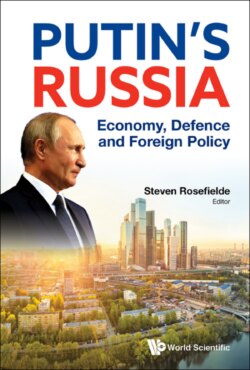Читать книгу Putin's Russia - Группа авторов - Страница 13
На сайте Литреса книга снята с продажи.
Macroeconomic Management
ОглавлениеPerfectly competitive freehold market economies in theory should perpetually maximise consumer utility. No one should be involuntarily unemployed, price levels should be stable and GDP should grow at the “golden age” rate of technological progress (Solow, 1956, 1957; Acemoglu, 2009). Business activities may fluctuate, but only as required by transitory factors and changes in people’s demand for leisure.
Imperfectly competitive market systems necessarily fail to meet these goals. Involuntary unemployment, business cycles, deficient economic growth and inflation may blight economic performance. Along with assistance from the World Bank and the International Monetary Fund, Russia tries to manage these disorders by applying the same macroeconomic tools used in the West. The Kremlin regulates the supply of money and credit with open market operations and uses fiscal policy to affect aggregate demand. It deficit spends (increases government purchases with borrowed money), reduces taxes, increases subsidies and devalues the ruble when business is weak, reversing the field when business is strong.
Russian macroeconomic management is a challenging task. The Kremlin’s banking system is weak, hampered further by Western economic sanctions that bar Russia’s access to medium and long-term international credit. State revenues are heavily dependent on volatile natural resource prices. Soaring oil prices swell Moscow’s coffers, flood the country with foreign direct investment and stimulate aggregate economic activity. Plunging natural resource prices reverse the process causing recessions and depressions. When the sun shines, Russian macroeconomic policymakers should avoid overspending, creating reserves for rainy days. The Kremlin has been prudent in this regard. Russia’s debt-to-GDP ratio is only 13.5%, a small fraction of the American figure.1
Russia’s macroeconomic performance more broadly has been good, given its exposure to natural resource price shocks. Its labour force participation rate is high,2 and its 4.8% unemployment rate is close to what World Bank economists consider full non-transitory employment,3 and the inflation rate is 3.4%.4 GDP growth is dyspeptic at 1.8% per annum, but still faster than the European Union,5 and real wages including pensions are growing. Russia ran a 35.4 billion dollar current account trade balance surplus in 2017 and holds relatively high levels of international reserves ($461 billion). It has low external debt levels (about 29% of GDP) and a comfortable import cover (15.9 months) that enables the Federation to readily absorb external shocks.6 The Kremlin’s primary foreign trade vulnerability lies in Russian dependence on natural resource exports to pay for the country’s imports. Export diversification is limited. Since 2014, Russia’s non-energy export volume growth has been outpacing that of energy, contributing to export diversification. Yet, Russia’s progress in export diversification is modest. The share of oil/gas exports in 2017 was still high at 59%, accounting for 25% of the fiscal revenue, with diversification mainly driven by established product lines.
There is little doubt that Russian macroeconomic performance in all these regards would be substantially better, especially its GDP growth rate, if the country were more competitive and the West lifted economic sanctions. Nonetheless, Kremlin macroeconomic policymakers have done a credible job, given Putin’s flawed Muscovite economic mechanism.
